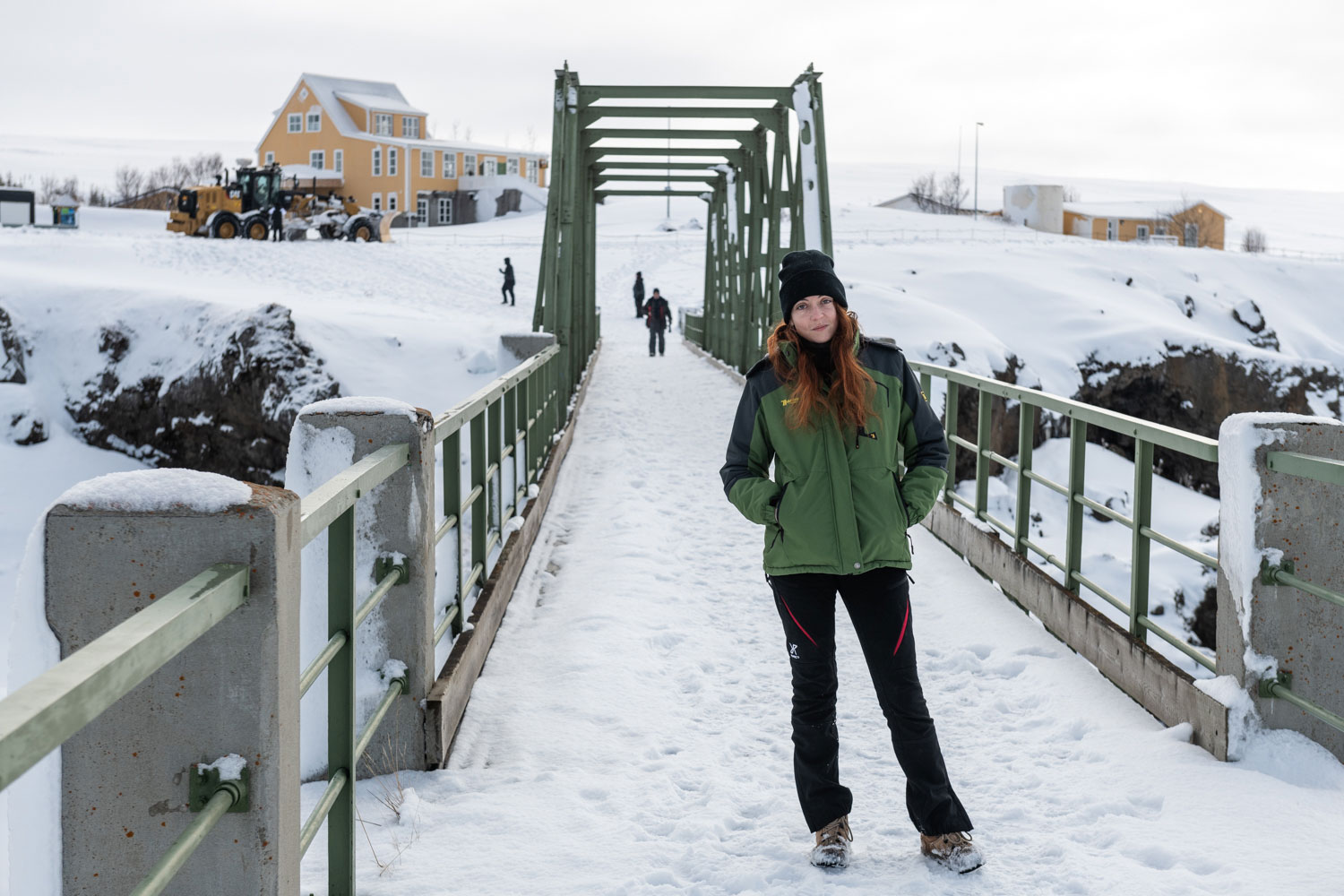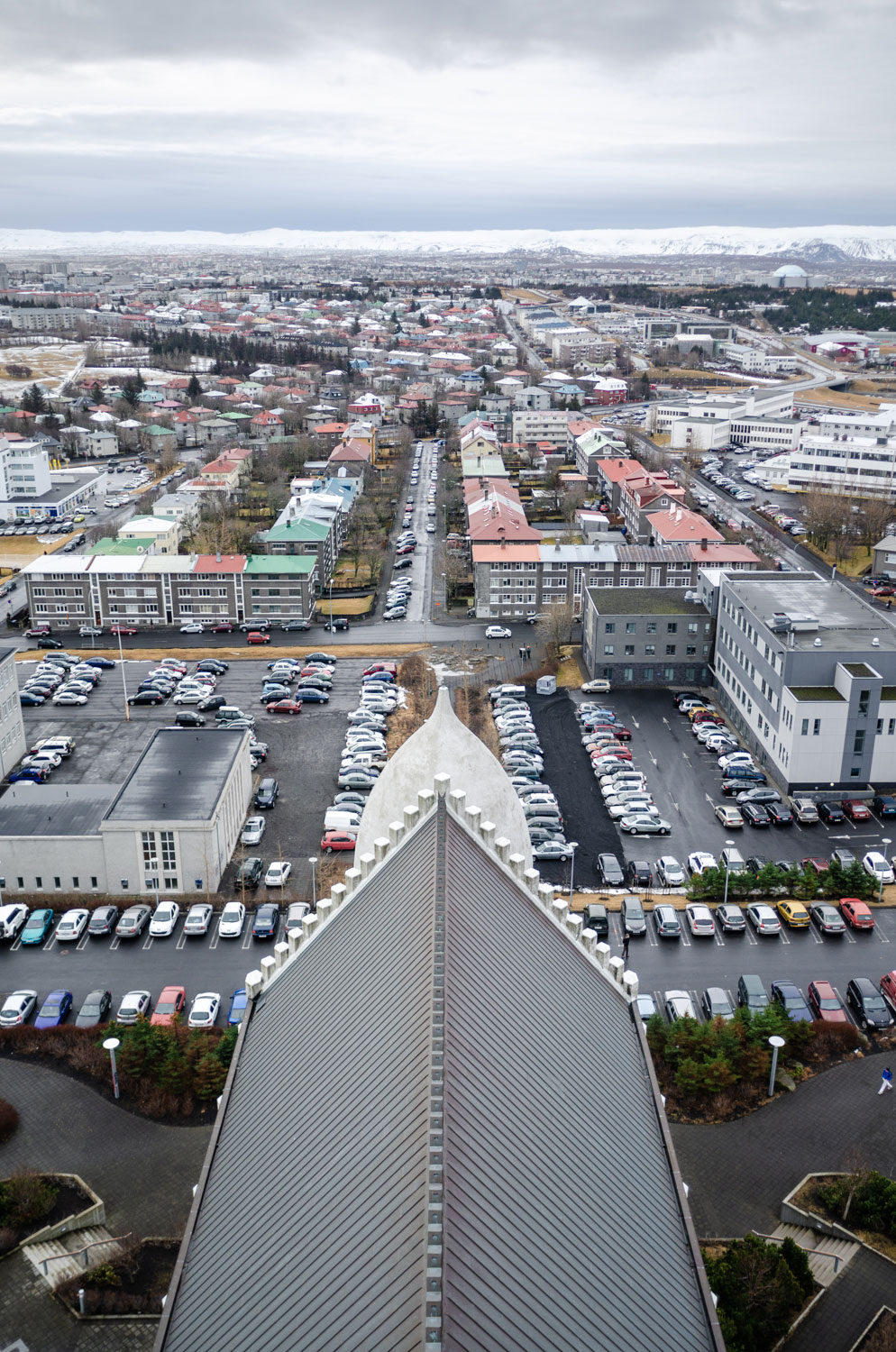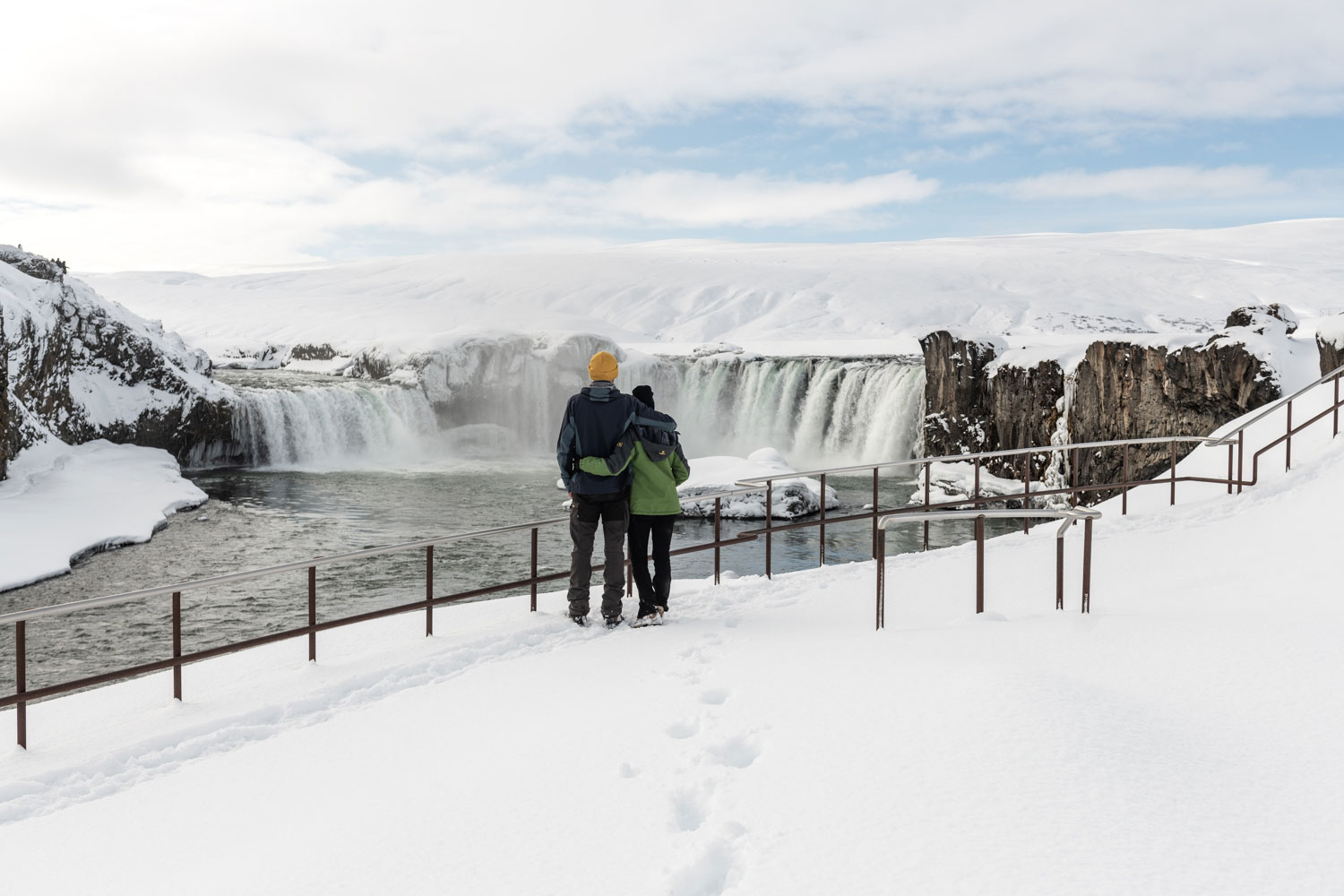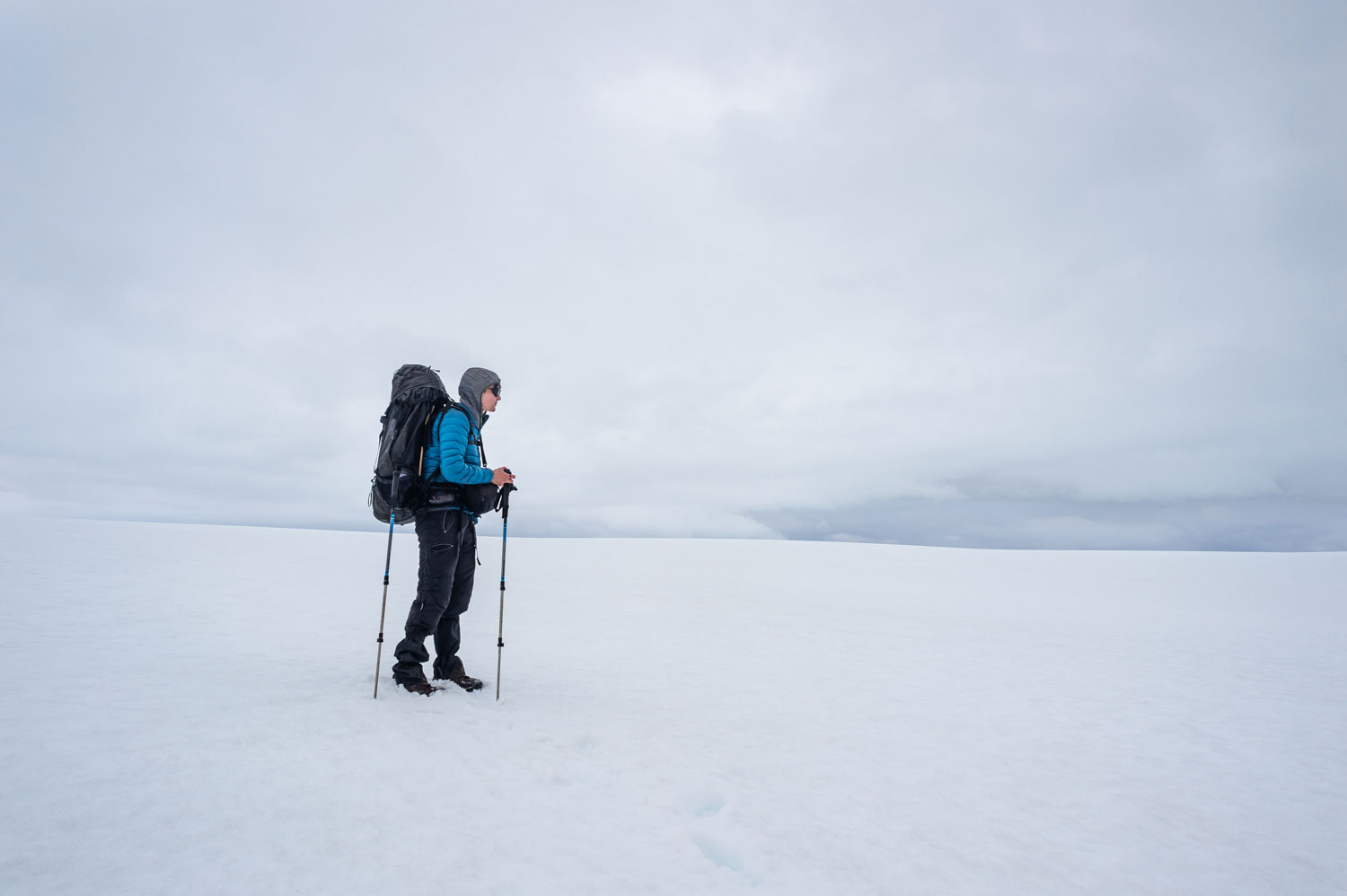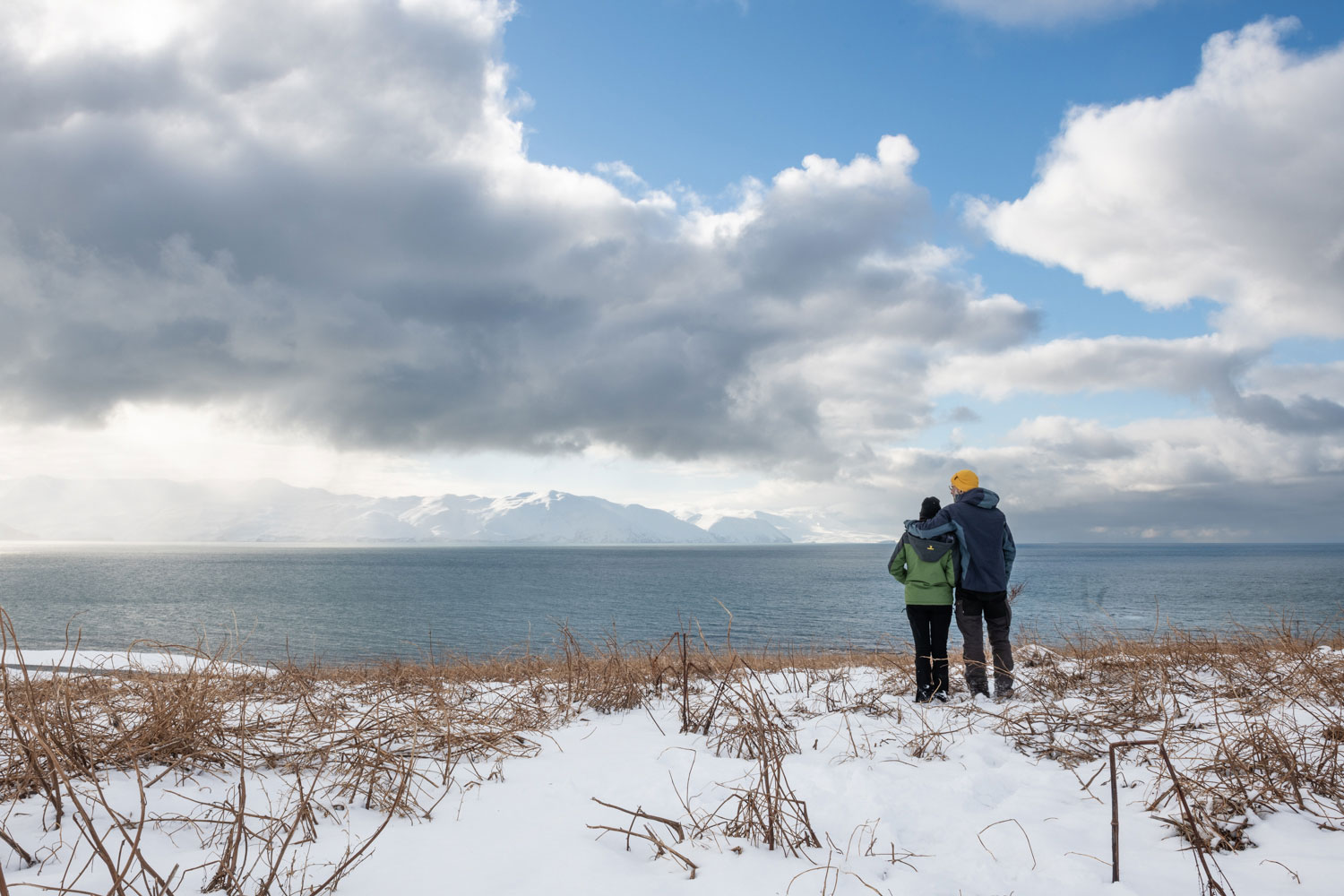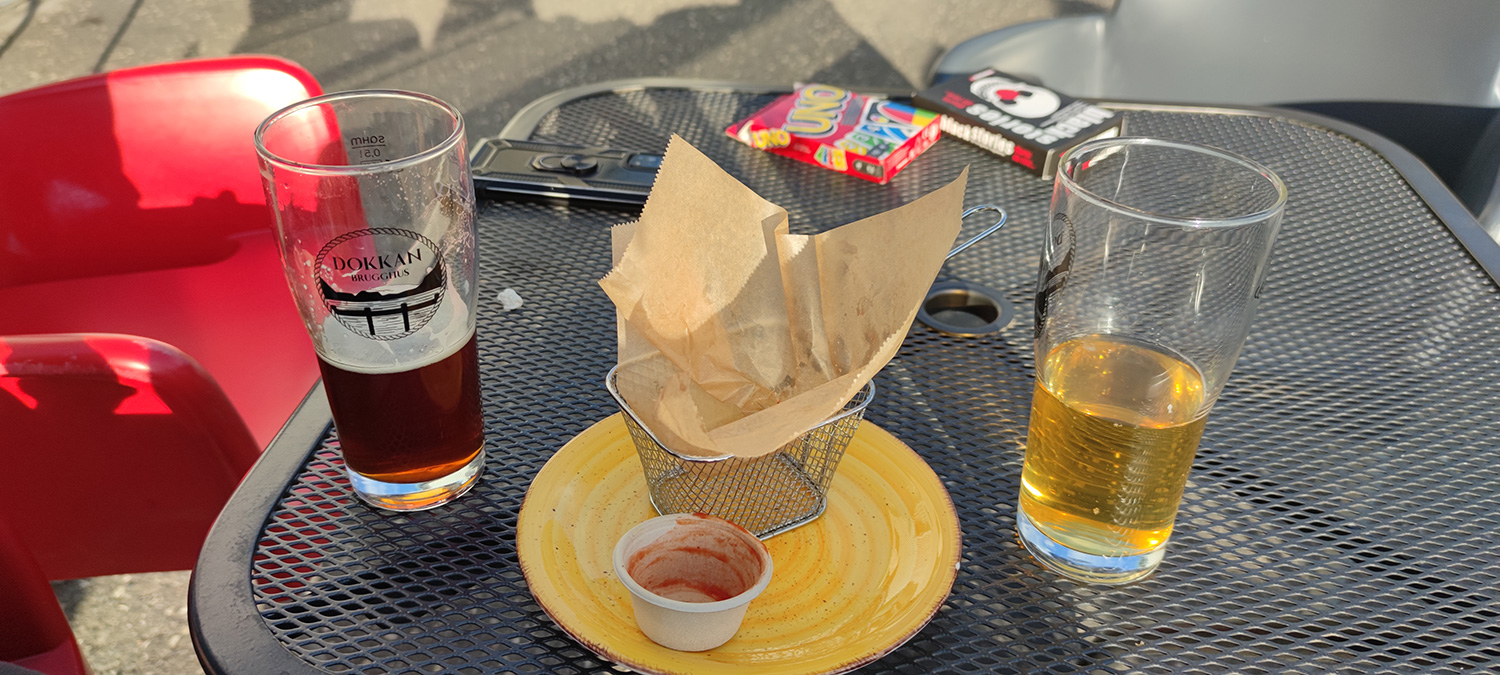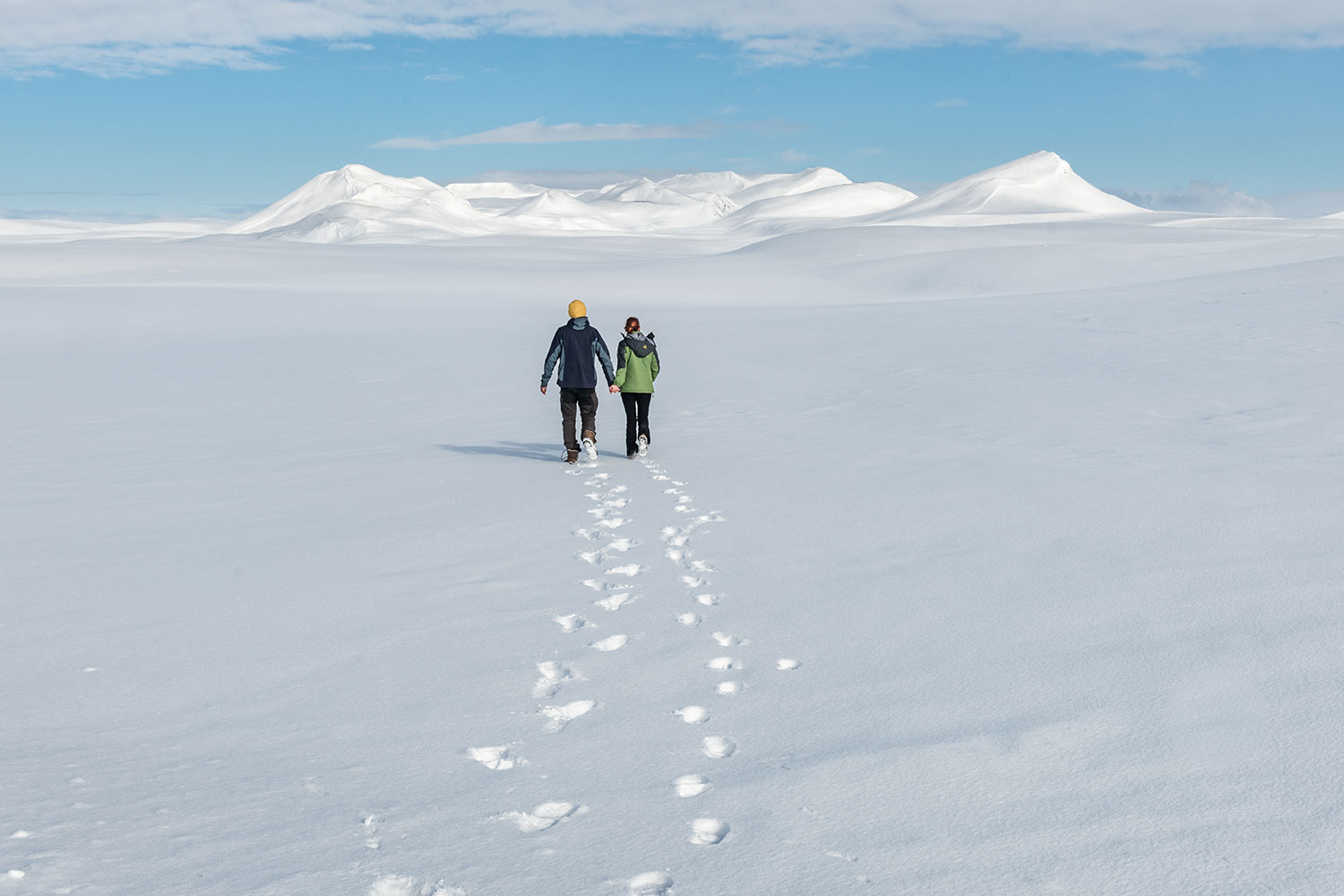Travel to Iceland in winter – The complete guide
What a crazy idea to travel to Iceland in winter! This country has all the natural and meteorological phenomena needed to be in trouble, at least at first sight. But the Icelanders have developed a rather comfortable country where it’s possible to get around, sleep in the warmth and visit in all circumstances… or almost.
Travelling to Iceland in February or March is a wonderful experience. With the beauty of the northern landscapes, the northern lights dancing in the sky and natural curiosities such as geysers, vertiginous waterfalls and volcanoes, the island is sure to leave a lasting impression on nature lovers. Looking back, this was the best time for us to visit Iceland. Not everything is easy, of course, but every difficulty is worth it!
If you’re wondering when to travel to Iceland, then you’ve come to the right place, follow the guide!
A few words about Iceland
Iceland is an island lost on the edge of the North Atlantic, between the continents of Europe and America. The island lies on the tectonic rift that separates these two continents. It is subject to both intense volcanic activity and extreme cold, given its position on the edge of the Arctic.
There are exceptional natural attractions all over Iceland. The island is a compendium of the most beautiful and majestic things nature has to offer: cascades and waterfalls, rivers, mountains and cliffs, fjords, glaciers, volcanoes, hot springs, caves and canyons make up most of the country.
Iceland has remained wild and untouched for a very long time. It was one of the last lands to be colonised by humans in 874, when the Viking arrived. It was then successively Norwegian and Danish before declaring its independence and the birth of the Republic of Iceland in 1944.
Today, Icelandic culture is at a crossroads, between the Viking heritage, European culture and American culture, which had a major impact on the island during and after the Second World War.
Finally, Iceland has enjoyed a boom in tourism over the last twenty years. This success has relegated the fishing industry, once the country’s leading industry, to second place. In 2023, 2.2 million tourists visited Iceland. These figures are very significant given the size of the island. It has to be said that there is a certain amount of discontent in the country, and the authorities are looking for new ways to regulate tourist flows and avoid the effects of over-tourism, particularly on nature and protected areas. As far as tourism is concerned, it’s best to travel to Iceland in winter.
The majority of tourists spend 3 or 4 days in Iceland in winter as in summer, but others stay for up to a month, in particular for self-sufficient treks in the highlands.
When to travel to Iceland in winter: December, January, February or March?
We asked ourselves what would be the best month to travel to Iceland in winter. It has to be said that December is very tempting with the end-of-year festivities. January too, to start the year under the northern lights. But we decided to travel to Iceland in March for several reasons:
- The days are long enough again to enjoy the Icelandic landscapes by day.
- The weather is calmer and it’s possible to experience both stormy days and days with big blue skies.
- Hiking is once again possible.
- The chances of seeing the Northern Lights are highest in March.
Flights are also very affordable at this time of year. It has to be said that the budget issue is very important in Iceland, as prices are so high. We estimated that travelling to Iceland in March was cheaper than travelling in December or January. So the low-budget holiday option weighed in the balance.
Finally, we wanted to have the opportunity to see wild animals such as reindeer in the East Fjords, and to do some landscape photography with beautiful sunrises and sunsets. All these criteria led us to decide to visit Iceland in winter in March.
Equipment to travel to Iceland in winter
Equipment is a key issue in Iceland, as visiting the country can turn into a nightmare with the wrong gear. The Icelanders say that “there is no bad weather, only bad clothes“. We decided to take this proverb to heart and seriously consider the question of equipment before we travel to Iceland in winter.
It has to be said that we’re used to harsh climates. We’ve visited cold countries quite a bit and Samy is a guide and wildlife photographer, so he’s no stranger to the cold!
What’s more, we plan to sleep in the hire car on some days. We planned to hire an estate car with enough space to put the seats down and make ourselves cosy beds. To do this, we had no room for error, either in terms of clothing or equipment, such as the sleeping bag. Iceland in March is more conducive to sleeping snug in a cosy bed, but we love a challenge!
Finally, during our winter trip to Iceland, we had planned various types of outing, both by car and on foot. This meant being prepared for both long exposure to the cold and shorter outings. And, being photographers, we had of course prepared the necessary equipment for photography in Iceland.
What to wear if you travel to Iceland in winter?
Knowing what to wear in Iceland in winter is a crucial question. As a general rule, in these countries you have to follow the onion-skin rule. In other words, pack as many layers as possible that you can pile on top of each other and remove if you get too hot. It would be a mistake to pack just one or two thick layers, such as a thick woollen jumper and a heavy winter jacket. Here’s our list of clothes for Iceland in winter (March):
- Thermal underwear: silk or merino wool leggings and a long-sleeved merino wool undershirt. If it’s cold, you can always pile them on!
- Mid-layer: Winter hiking trousers (fleece lined) and thin fleece.
- Outer layer: thick fleece
- Waterproof layer: Waterproof winter jacket and overtrousers for hiking.
- For extremities: a pair of fine silk gloves and a pair of ski gloves, several pairs of merino socks, a woollen choker and a woollen hat.
- A pair of warm walking boots (winter hiking boots).
If you stack these layers correctly, then the question of choosing a winter coat for Iceland is less crucial, because you’re already well protected. You can then take off or put on layers depending on the circumstances. Indoors, you can keep just the merino undershirt. Outdoors in fine weather (i.e. no wind!), your thick fleece could be enough. Finally, in bad weather, your winter jacket and rain trousers will protect you from the elements.
If you travel to Iceland in winter to hike in the snow, a pair of gaiters is useful to prevent the snow from getting into your boots.
Given the price of clothing in Iceland, we took the time to prepare well to avoid having to buy equipment there.
Our backpack to travel to Iceland in winter
We’re used to travelling with big hiking bags (around 70L each), simply because it’s more practical for us! It allows us to take everything we need without lugging around a suitcase. If you know how to pack your rucksack so that the things you need most (toiletries, clothes, etc.) are within easy reach, then everything becomes easier!
Here’s what we think is important to pack if you travel to Iceland in winter:
- A compression bag for clean clothes and another for dirty clothes (otherwise a plastic bag is enough). It’s very practical, you empty the air and the bag is very easy to store!
- Snacks of all kinds: you’re likely to be cold outside, so you need to warm up regularly! To make sure you last longer in the cold, we advise you to take plenty of snacks, preferably sweetened and not reduced in fat.
It may seem counter-intuitive, but the better nourished you are, the less you’ll feel the cold! - You can take a pot and buy gas at any Bonus or petrol station. But be careful of the wind, and don’t let it snow outside! You don’t realise how much snow can fall in a matter of minutes, and your crockery waiting to cool on the ground could end up swallowed up by the snow. Keep an eye on it 😉
- One 1L flask per person. You don’t need to buy bottled water! Tap water in Iceland is healthy and delicious, and you can refill easily at any petrol station (just ask, staff can’t refuse) or on your walks, in waterfalls and rivers. Outdoors, just check that animals are not in the immediate vicinity and that the water flow is strong enough to keep the water clean. It comes directly from the glaciers where no animals live, and it’s one of the rare countries where you can drink water directly from waterfalls or rivers!
The best time to go to Iceland for backpackers is obviously in summer, but anything is possible in winter, provided you are well prepared and have a minimum of experience.
In the wash bag :
- The usual toothbrush + toothpaste combo
- Biodegradable soap (and shampoo too). We prefer to have solid blocks when we travel, which we cut up if necessary to save space.
- Sun cream (yes, don’t be fooled by the grey skies, the sun beats down hard over there!) and moisturiser to counter the aggression of the cold and wind.
- Vaseline to protect your lips and nose if you tend to blow your nose.
- Standard first-aid kit
- Your holiday essentials! You can take a book with you, although it’s a safe bet that with the landscapes you’ll be coming across, you’ll probably spend most of your time looking at the roads and magnificent scenery.
- Powerbank for mobile phones (you can recharge at petrol stations, but it’s always a good idea not to run out while out and about).
- We recommend a small notebook to keep a record of all the places you visit. Even a digital one will do 🙂
During a road-trip in Iceland, you drive for hours on end, stopping in lots of little places. It’s a wonderful flexibility, but sometimes you can forget about a charming village that you want to remember! This also applies to artistic minds who would like to sketch the landscapes in a dedicated notebook. After all, going to Iceland in winter is very inspiring for artists, painters and photographers.
Your phone and an efficient internet connection:
You’ll need your phone at least to check the route, the distance to your next stops and, above all, to plan your “refuelling” breaks. In fact, sometimes you’ll be on a road several hundred kilometres long with no petrol station (and sometimes no network). So it’s best to plan ahead and look after yourself!
In winter, roads other than the main access routes (Route 1) are often closed. Even though many sites are accessible close to the main roads, some require a short drive before you get there.
Avalanches and slippery ice-covered roads can make the roads impassable.
So you need to plan your itinerary, giving yourself a little flexibility: you may have to postpone your stopover for a few hours on D-day, or even until the day after, especially if you have to take a track to get there.
The map available on road.is is updated very regularly, and shows you what the travel conditions are, which roads are open, and for the main routes, you even have a webcam.
So it’s essential to have at least one phone dedicated to GPS, and another that’s frequently used to check whether roads are open or not, and if so, in what condition (slippery? Snowy?). It’s then up to you to decide whether you’re comfortable with the conditions, or whether you’d prefer to deviate from the route or delay your departure.
If you’re planning to travel to Iceland in winter, it’s important to note that closed roads (in red on the map) are not always indicated by signs!
In Iceland, everyone is expected to be responsible for their actions, and to act accordingly. Icelanders expect you to find out before you set off, by checking the site indicated above.
If the road is closed, you run the risk of an accident. In this case, you will of course be rescued, but as you are at fault, you will be billed for all the costs incurred by the emergency services (and we’re talking about Iceland, so several thousand euros!).
If you sleep in the car:
If you travel to Iceland in winter and stay in a hotel, gîte or youth hostel, this section is not for you.
But if you’re like us, not too keen on the comfort of a bed and with a desire to visit Iceland in winter on a tighter budget, this section is for you!
A word of warning though: storms are frequent and unpredictable in winter. So it’s possible that you’ll learn with just an hour’s notice (or less) that the road you’d planned to take is going to close. And in such cases, we strongly advise against sleeping in the car. The snow will pile up, and it will be extremely difficult to get out of the car in the morning (in addition to the cold and the strong wind that will shake the car). We therefore advise you to budget flexibly for one or two nights in a hotel. If you don’t have any unforeseen problems on the way, this could come in handy on your return home or for more paid activities! Otherwise, you’ll be glad to have some shelter.
So, with that out of the way, let’s plan something to make a cosy nest in the car!
What to bring:
- An inflatable mattress (we take trekking mattresses, which are quite thin). The car isn’t uncomfortable once the seats are down, and we fill the holes with clothes!
- A sleeping bag (-10°, down is ideal. 0° won’t be warm enough).
- Nightwear (fleece or merino leggings and undershirt, fleece gloves and a fleece hat). You can keep your warm merino day socks for the night! Personally, I’d taken a pair of pilou-pilou socks with me, and I was very happy to find them when the dampness crept through the boot door!
- The sacrosanct headlamp, so you can create your cosy nest for the night in no time at all!
Sleeping in the car is one of the best ways to see the Northern Lights, especially if the car has a sunroof. It’s also a great way to see wildlife in Iceland such as the Arctic fox and reindeer.
If we sleep in the car in Iceland, how do we shower?
Well, that’s an excellent question! We chose to shower in Iceland’s municipal pools.
It seemed to us to be the ideal solution: as a full nude shower is compulsory before entering the pools, we could also take advantage of the opportunity to splash around for a few minutes (and sometimes a few hours…) in 40° water, meet people and have a chat, take advantage of the sauna when the pools have them…
But you do have to pay an entrance fee to the pools (usually around €8).
Showers are also sometimes available near hot springs in geothermal areas, as long as you are prepared to shower in an unheated space. These pools are sometimes free, but sometimes charge, as a sign will tell you.
Another option is to shower at campsites. Generally speaking, you have to pay for an overnight stay to use the campsite facilities. As we sleep on the roads, this didn’t necessarily seem appropriate, which is why we never do it outside the Reykjavik campsite. If you choose this option, be sure to check when the campsites are open! Some close during the winter.
As for toilets, we prefer (as Icelanders ask tourists to do, incidentally) not to relieve ourselves directly in nature.
There are many petrol stations along the roads, and most of them have free and accessible toilets. If this is not the case, shops or restaurants will be able to open the doors to the toilets for you.
And if you’re in a nature park, you’ll always find a toilet there, even if it’s just a spare one. So no more toilet rolls in the car, unless it’s a real emergency!
We also recommend our article on hygiene when hiking, to help you learn how to keep clean if you’re planning to go to Iceland in winter or summer, for that matter.
Travel to Iceland in winter: what to eat and drink
In the past, food resources were scarce in Iceland, due to the harsh winters and nutrient-poor soil. The emphasis was therefore on a simple diet, based mainly on fish and roots.
With the arrival of the modern era, industrialisation and imports, Icelandic cuisine has been able to renew itself while remaining rooted in its culinary identity. Before travelling to Iceland in winter, you need to be aware of what you can (and can’t) find in the country.
Icelandic fish and meat
First of all, Icelanders are, and always have been, big consumers of animal protein. As mentioned earlier, this is part of their culture: with the soil producing few nutrients and the layer of earth being thin, it has been difficult to grow anything other than roots and other cold- and storm-resistant vegetables. So we’ll say very little about vegetables here!
The majority of traditional Icelandic dishes therefore revolve around fish, which for centuries was Iceland’s main source of food and income. Langoustine, cod and haddock are the fish most often found on the menu, usually accompanied by potatoes. Fish and seafood stew is one of Iceland’s signature dishes.
Other typical dishes, such as fermented shark and whale blubber, are usually reserved for celebrations such as the Midwinter Festival.
Other popular meats include mutton and lamb. Like fish, it was one of the few resources that enabled Icelanders to survive the harsh winters.
Dried or smoked mutton cuts can be found at gas stations and supermarkets throughout Iceland. They are also incorporated into hot dogs, part of the typical Icelandic street-food. You’ll also find a wide range of lamb soups.
Boiled sheep’s head is also a festive dish, eaten at celebratory banquets.
Travelling in Iceland, you’ll come across very few cows and even fewer pigs! They are only late imports. Until recently, milk was mainly consumed from ewes, and pork and beef were luxury foods, as they were imported – and therefore very expensive. It was generally only eaten at Christmas.
Icelandic soups
It’s one of the simplest dishes to prepare, and yet it’s a real treat!
From meat and fish soups to the famous mushroom soup, Iceland has everything to satisfy your taste buds!
Traditionally, soups were made from fish or mutton.
Then, with industrial progress, and in particular the use of geothermal energy in agriculture, many vegetables began to grow in Iceland.
This is particularly true of tomatoes (a large tomato greenhouse can be visited in southern Iceland, near the Golden Circle). And you can now enjoy delicious tomato soup in Iceland!
What makes them special is their seasoning. It’s hard to find the exact traditional recipes online, but it seems that the secret lies in several ingredients: skyr, dill, but also oils infused with local herbs (dill, arctic thyme, etc…). Travel to Iceland in winter is the perfect opportunity to try this delicious dish!
Many mushrooms grow in Iceland. They make delicious mushroom soups that will stay with you for a long time!
Skyr, the national product!
Skyr, now available even in our European supermarkets, is one of Iceland’s signature dishes. Eaten with blueberries, porridge, jam, cereals, incorporated into recipes or even eaten plain, it has been part of the Icelandic diet for centuries!
Although it has the consistency of yoghurt, its production process makes it more of a cheese.
The recipe was brought over by the Vikings when they colonized Iceland. The process involved separating the milk from the cream. The milk was then brought to the boil (pasteurized, in other words), and active “skyr” cultures (from previous productions) were added to curdle the milk.
The curds were then filtered to separate them from the whey. Leftovers were used as beverages or to preserve meat.
This food, very rich in protein and calcium and low in fat, is still widely consumed today, and is often marketed in a variety of flavors (vanilla, blueberry, mango, etc.). It’s impossible to go to Iceland in winter without tasting Skyr!
Icelandic bread
When the Vikings colonized Iceland, they were determined to settle there and lead a life similar to the one they had in Scandinavia.
This meant having livestock, and farming to produce the wheat needed to make bread.
Their farming practices, too intensive for the country, coupled with the climate, led to significant soil erosion and deforestation. This is why there are so few trees in Iceland, and the small forests that do exist are protected and considered a source of pride. Given the conditions, to grow a tree several meters high takes many years (even centuries) and can be considered an achievement.
The destruction of soil and trees has left the soil incapable of producing vegetables other than roots and cabbage. In a few areas, barley was still grown, but it was too fragile to withstand the Icelandic winters and the long cold period ahead.
Subsequently, bread became a luxury, as wheat had to be imported.
Today, barley and oats are grown again, and Icelanders have re-established bread as an important part of the meal.
Traditionally flat, and made from rye, you’ll find many kinds of bread to try out when you travel to Iceland in winter.
Desserts and sweets from Iceland
There’s no better time to travel to Iceland when it comes to desserts and sweets! Icelanders have made the most of the ingredients at their disposal to create a wide range of desserts! From pancakes served with cream, to skyr, to rhubarb jam, you’ve got plenty of options to explore in Iceland!
The Icelandic doughnut is called the kleina. It’s very similar to the bugne lyonnaise.
If you’re more into cakes, you can indulge in snudur, a cinnamon-glazed roll directly inspired by Swedish kanelbullars.
And finally, there’s the famous happy marriage cake, an oat-based cake filled with rhubarb jam.
You can also indulge in Icelandic ice cream – a popular snack after a hot-spring, and usually sold near municipal swimming pools. These are Italian-style ice creams, often dipped in caramel or chocolate icing, which you can sprinkle with fruit, dried fruit or even pieces of candy (m&m’s, twix, etc.).
Icelanders have also developed what is known as the traditional sweet: Icelandic licorice!
It was introduced at a time when neither sugar nor honey had reached Iceland. It was therefore very popular with Icelanders, and was also used for its medicinal properties.
In the 20th century, wars and restrictions made it virtually impossible to import, so the Icelanders developed their own licorice.
The café
You’ll find hot coffee everywhere in Iceland!
From gas stations (where some still offer free coffee to passengers) to restaurants, to certain offices (banks, etc.), the hot drink has become part of the country’s habits!
Often drunk with milk and sugar, or even flavored syrups, Icelanders are big coffee drinkers.
Soft drinks
We mentioned above that Icelanders drink a lot of coffee. And caffeine is an integral part of the majority of sodas consumed locally!
Icelanders certainly love sweets. In every supermarket, you’ll find a wide selection of sodas, often sugar-free (since recent government measures to curb sugar consumption) and in every conceivable flavor!
The most famous is undoubtedly Collab soda. This Icelandic brand produces sodas with caffeine and collagen supplements. The exotic, original flavors have won over young people, who are rarely seen without their can of Collab! Collagen is extracted from the skins of fish caught in Icelandic fishing factories.
Icelandic beer
When the Vikings settled in Iceland, they also brought with them their knowledge of how to brew beer. As a result, beer was consumed for many centuries.
Nevertheless, Iceland, like many other countries at the same time, went through a period of prohibition at the beginning of the 20th century.
While moral reasons, associated with the temperance movement, played a major role, there was also the struggle for independence from Denmark.
As beer was linked to Scandinavian countries, it was not the “patriotic” choice for a drink. Alcohol prohibition came into force in 1915.
In the 1920s, Iceland came into conflict with Spain and Portugal. The latter threatened to stop importing salt cod if Iceland did not accept wine imports. Prohibition was eased slightly, and spirits below a threshold of 2.25% were allowed in trade.
During this period, Icelanders still secretly brewed their own beer, which was higher in alcohol than the permitted levels.
In order to enjoy an alcoholic drink, it was common practice to add a few drops of strong alcohol to a glass of beer, notably Brennevin.
In the 1930s, restrictions on the production of hard liquor were lifted, although the brewing and consumption of beer remained prohibited.
Restrictions on beer were lifted definitively in 1989, and Icelanders still celebrate the lifting of the ban on March 1st, Beer Day. For beer lovers, to travel to Iceland in March is the best option!
Beer is still the most widely consumed alcohol in Iceland, and you’ll find many craft breweries everywhere.
For our part, we recommend Viking beer, a simple blonde, Einstök white ale (a white beer with character), and especially Fossavatn from the Dokkan brewery, produced in Isafjordur.
Icelandic spirits
Icelandic spirits have a unique taste. Icelanders boast about the purity of the water used, but also about the local ingredients, which are not found in the majority of other strong spirits on the market.
Juniper berries, Arctic thyme, birch branches and even Icelandic moss are all ingredients in the schnapps, gins and cocktails served.
Birch liqueur, licorice liqueur, gin and schnapps arranged with moss are all traditional spirits, and in some cases have long been used for the medicinal properties of the plants they contain.
Landi, Icelandic moonshine, was long produced and sold under the table.
And finally, Brennivín (literally “burnt wine”), nicknamed “Black Death”, is Iceland’s signature spirit. This caraway-flavored brandy has been produced since the 1930s. Usually drunk chilled, it is now reserved for special occasions, to accompany festive dishes, where its taste is used to enhance the dishes.
Brennivín was originally produced by the Icelandic state and marketed under a black label, to avoid making the drink attractive. Today, this black label is still found on commercially available bottles.
Travel to Iceland in winter: Pitfalls to avoid
Paid parking
In recent years, Iceland has seen an explosion in the number of pay-and-display parking lots! Mass tourism is forcing Icelandic authorities and landowners to develop areas that were once wild, creating parking lots and hotels nearby. The whole thing loses a little of its charm, but certain behaviors help us to understand the authorities’ choice.
Some parking lots cost $8! Even for Iceland, these prices are very high. And that’s not the only problem. To control payments, the Icelandic government has opted for cameras and an automated system. If you enter a parking lot by mistake, before you realize you’re paying, it’s already too late: the camera has scanned your license plate. What’s more, even if you’re in a rental car, the rental company will charge you when you return, with a penalty for not having paid the parking fee directly.
We were tricked once with these parking cameras in Iceland. After that, we systematically looked out for signs and cameras before entering the parking lots.
Unfortunately, on certain must-see spots like Vík’s black sand beach, there’s no alternative to paid parking, unless you walk several kilometers.
Don’t hesitate to take a look at Google Maps, where many of Iceland’s paid parking lots are indicated (comments are your best friend!).
Car rental in Iceland
We’ve rented cars in Iceland several times, and we’ve had a few setbacks.
Lack of preparation (yes, we’re part of the “plan everything at the last minute” team), lack of experience, or just plain carelessness, we thought compiling all our tips might help you avoid the problems we’ve had with car rental in Iceland!
Before renting a car in Iceland, it’s a good idea to check out the insurance options for the places you’ll be visiting. If you’re going to the south, and particularly the south-east, it’s imperative to take out insurance to cover damage caused by sand and ash. Indeed, in addition to scratching the bodywork, these small debris can damage the windscreen, so that visibility is extremely reduced by the thousands of tiny splinters on the glass…
On a road trip to Iceland in winter, be sure to check that damage to the underbody and chassis is also included. Under deep snow can hide a big rock!
In short, don’t take this step lightly.
As for the highest level of insurance, which allows you to cross rivers, unless you’re visiting the Highlands, you won’t need it. And in that case, you’ll need to hire a specific vehicle for the mountain conditions on site, not just a 4×4.
In winter, 4×4 vehicles are mandatory. Beyond its comfort, it will enable you to get out of a situation where you’re on an icy road (which is more than likely), but also to get your car out of the snow.
Make sure that when you rent a car in Iceland, you have chosen the “unlimited mileage” option. There’s a lot of driving in Iceland, and from one region to another. Any other type of mileage will be insufficient, and you’ll have to pay the rental company a hefty surcharge. It’s best to have this option included in your rental package from the outset.
Some car rental companies in Iceland (not the biggest, but we’ve been there) ask for a credit card. In France, we tend only to have a debit card. Find out in advance about the means of payment required, in which case the agency may ask you to take out additional insurance (at a high price) to cover any towing or accident.
Accommodation
Winter is the off-peak season, so it’s easier to find accommodation in Iceland at lower rates. That’s why it’s the best time to go to Iceland!
Airbnb rentals will be less easy to find, but many cottages and guesthouses will be available to accommodate you. Most campsites are closed during this period.
Nevertheless, the south coast remains very popular. For this part of the country, it’s important to book accommodation in advance to avoid unexpected costs.
Finally, Iceland’s beauty in winter also lies in its climate. The swirling snow, icy lakes and black rocks powdered with white are magnificent.
The counterpart to these conditions is the possibility of a storm, which arrives suddenly.
As well as keeping a regular check on weather and road conditions, we advise you to budget for 1 or 2 nights’ hotel accommodation, to be booked quickly if the opportunity arises and you’re a long way from your next stopover (or the road is closed there). Having a fallback solution is always important when traveling in Iceland in winter.
To avoid losing money on your reservations, be sure to let hoteliers know that you won’t be able to reach your next stopover when you’re certain of unfavorable conditions.
Travel to Iceland in winter : The classic tourist routes
As a general rule, we tried to avoid touristy places and shops in Iceland as much as possible. We have to admit that we quickly leave crowded places. We’d rather go for a walk in a remote Icelandic fjord than queue up to visit an exceptional natural site. And for us, going to Iceland in March was perfect for that!
Timing was also important. Whenever a visit was important, we favored early and late slots to avoid the crowds.
Iceland is a wonderful country, and relying on tour guides alone would be a mistake. You quickly realize that these guides offer the same attractions and the same tours. The aim is obviously to make a profit. So we avoided the guidebooks as much as possible and did our own research, map in hand, to find interesting sights to visit. We think that this approach will be of interest to many of our readers who want to travel to Iceland in winter.
The north of Iceland was more conducive to our approach than the south. Every valley, every fjord, every mountain was interesting to visit. And it has to be said that there isn’t a living soul in these parts, apart from the few Icelandic farms scattered here and there and Icelandic horses in the mountains.
To the west of Akureyri, for example, it’s possible to take countless walks without ever coming across anyone. The same applies to the Westfjords between Hólmavík and Ísafjörður.
Finally, however, it’s important to remember that you need to be well-prepared if you want to explore Iceland’s remote areas. Indeed, the unpredictable climate can be dangerous for the inexperienced or ill-prepared. As a general rule, you shouldn’t rely on the weather forecast, and always pack clothes for worst-case scenarios.


